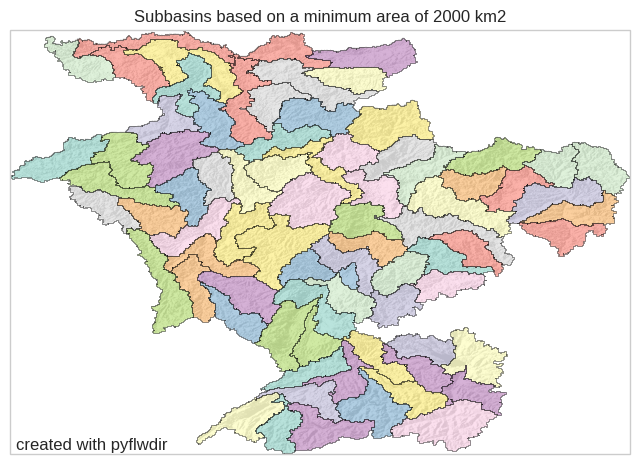Delineation of (sub)basins#
Here we assume that flow directions are known. We read the flow direction raster data, including meta-data, using rasterio and parse it to a pyflwdir FlwDirRaster object, see earlier examples for more background.
[1]:
# import pyflwdir, some dependencies
import geopandas as gpd
import numpy as np
import rasterio
import pyflwdir
# local convenience methods (see utils.py script in notebooks folder)
from utils import vectorize # convenience method to vectorize rasters
from utils import quickplot, colors, cm # data specific quick plot method
# read and parse data
with rasterio.open("rhine_d8.tif", "r") as src:
flwdir = src.read(1)
crs = src.crs
flw = pyflwdir.from_array(
flwdir,
ftype="d8",
transform=src.transform,
latlon=crs.is_geographic,
cache=True,
)
Outlet based (sub)basins#
The basins() method delineates (sub)basins defined by its outlet location. By default the method uses pits from the flow direction raster as outlets to delineate basins, but if outlet locations are profided these are used instead. An additional streams argument can be added to make sure the outlet locations are snapped to the nearest downstream stream cell, using the
[snap()](https://deltares.github.io/pyflwdir/latest/_generated/pyflwdir.FlwdirRaster.snap.html method under the hood. Here streams are defined by a minimum Strahler stream order of 4.
[2]:
# define output locations
x, y = np.array([4.67916667, 7.60416667]), np.array([51.72083333, 50.3625])
gdf_out = gpd.GeoSeries(gpd.points_from_xy(x, y, crs=4326))
# delineate subbasins
subbasins = flw.basins(xy=(x, y), streams=flw.stream_order() >= 4)
# vectorize subbasins using the vectorize convenience method from utils.py
gdf_bas = vectorize(subbasins.astype(np.int32), 0, flw.transform, name="basin")
gdf_bas.head()
[2]:
| geometry | basin | |
|---|---|---|
| 0 | POLYGON ((5.55833 51.89167, 5.55833 51.88333, ... | 1 |
| 1 | POLYGON ((6.45833 50.425, 6.45833 50.41667, 6.... | 2 |
[3]:
# plot
# key-word arguments passed to GeoDataFrame.plot()
gpd_plot_kwds = dict(
column="basin",
cmap=cm.Set3,
legend=True,
categorical=True,
legend_kwds=dict(title="Basin ID [-]"),
alpha=0.5,
edgecolor="black",
linewidth=0.8,
)
points = (gdf_out, dict(color="red", markersize=20))
bas = (gdf_bas, gpd_plot_kwds)
# plot using quickplot convenience method from utils.py
ax = quickplot([bas, points], title="Basins from point outlets", filename="flw_basins")
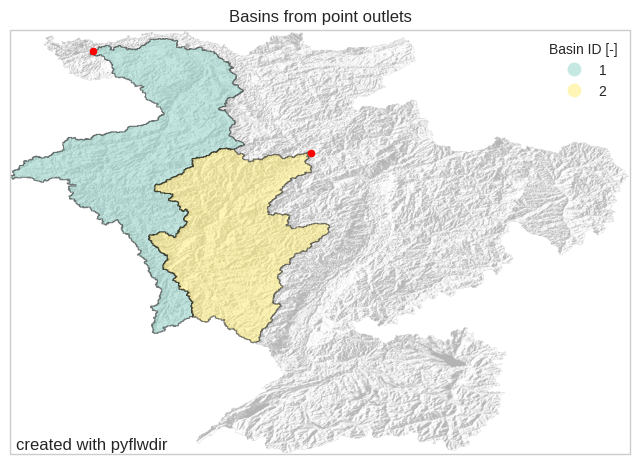
Stream order subbasins#
The subbasins_streamorder() method creates subbasins at all confluences where each branch has a minimal stream order set by min_sto. An optional mask can be added to select a subset of the outlets (i.e. confluences) which are located inside the mask.
[4]:
# calculate subbasins with a minimum stream order 7 and its outlets
subbas, idxs_out = flw.subbasins_streamorder(min_sto=7, mask=None)
# transfrom map and point locations to GeoDataFrames
gdf_subbas = vectorize(subbas.astype(np.int32), 0, flw.transform, name="basin")
gdf_out = gpd.GeoSeries(gpd.points_from_xy(*flw.xy(idxs_out), crs=4326))
# plot
gpd_plot_kwds = dict(
column="basin", cmap=cm.Set3, edgecolor="black", alpha=0.6, linewidth=0.5
)
bas = (gdf_subbas, gpd_plot_kwds)
points = (gdf_out, dict(color="k", markersize=20))
title = "Subbasins based on a minimum stream order"
ax = quickplot([bas, points], title=title, filename="flw_subbasins")
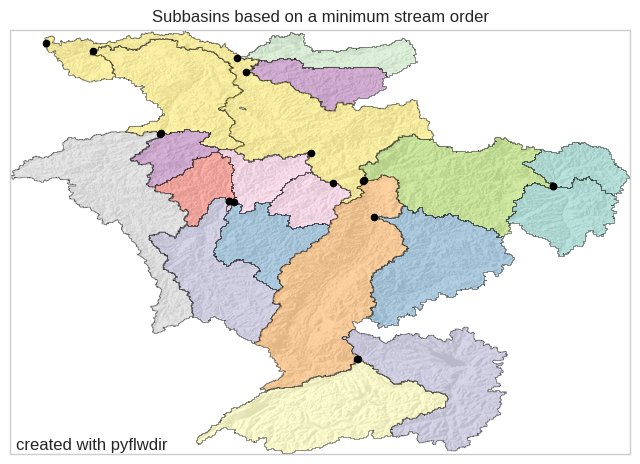
Pfafstetter subbasins#
The subbasins_pfafstetter() method creates subbasins with the hierarchical pfafstetter coding system. It is designed such that topological information is embedded in the code, which makes it easy to determine whether a subbasin is downstream of another subbasin. At each level the four largest subbasins have even numbers and five largest interbasins have odd numbers. The depth argument
is used to set the number of subbasin levels, i.e.: depth=1 nine, and with depth=2 81 sub/interbasins are found. The subbasins_pfafstetter method requires upstream area of each cell, which is calculated on the fly if not provided with the uparea argument.
[5]:
# get the first level nine pfafstetter basins
pfafbas1, idxs_out = flw.subbasins_pfafstetter(depth=1)
# vectorize raster to obtain polygons
gdf_pfaf1 = vectorize(pfafbas1.astype(np.int32), 0, flw.transform, name="pfaf")
gdf_out = gpd.GeoSeries(gpd.points_from_xy(*flw.xy(idxs_out), crs=4326))
gdf_pfaf1.head()
[5]:
| geometry | pfaf | |
|---|---|---|
| 0 | POLYGON ((4.10833 51.925, 4.10833 51.91667, 4.... | 1 |
| 1 | POLYGON ((5.88333 52.00833, 5.88333 51.99167, ... | 3 |
| 2 | POLYGON ((8.95 51.075, 8.95 51.06667, 8.93333 ... | 5 |
| 3 | POLYGON ((8.96667 50.61667, 8.96667 50.60833, ... | 6 |
| 4 | POLYGON ((5.55833 51.89167, 5.55833 51.88333, ... | 2 |
[6]:
# plot
gpd_plot_kwds = dict(
column="pfaf",
cmap=cm.Set3_r,
legend=True,
categorical=True,
legend_kwds=dict(title="Pfafstetter \nlevel 1 index [-]", ncol=3),
alpha=0.6,
edgecolor="black",
linewidth=0.4,
)
points = (gdf_out, dict(color="k", markersize=20))
bas = (gdf_pfaf1, gpd_plot_kwds)
title = "Subbasins based on pfafstetter coding (level=1)"
ax = quickplot([bas, points], title=title, filename="flw_pfafbas1")
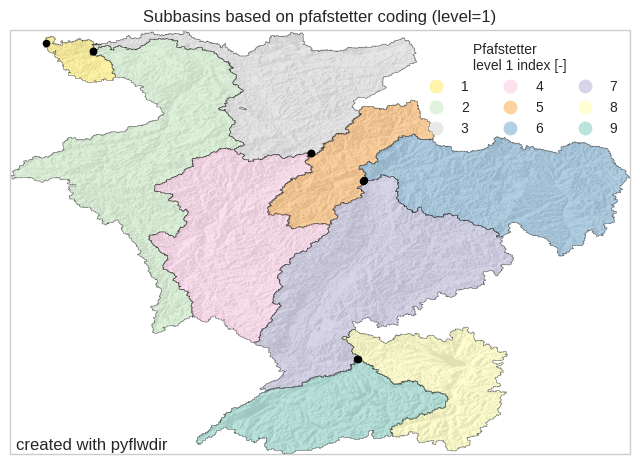
[7]:
# lets create a second pfafstetter layer with a minimum subbasin area of 5000 km2
pfafbas2, idxs_out = flw.subbasins_pfafstetter(depth=2, upa_min=5000)
gdf_pfaf2 = vectorize(pfafbas2.astype(np.int32), 0, flw.transform, name="pfaf2")
gdf_out = gpd.GeoSeries(gpd.points_from_xy(*flw.xy(idxs_out), crs=4326))
gdf_pfaf2["pfaf"] = gdf_pfaf2["pfaf2"] // 10
gdf_pfaf2.head()
[7]:
| geometry | pfaf2 | pfaf | |
|---|---|---|---|
| 0 | POLYGON ((5.88333 52.00833, 5.88333 51.99167, ... | 31 | 3 |
| 1 | POLYGON ((7.325 51.975, 7.325 51.95, 7.30833 5... | 32 | 3 |
| 2 | POLYGON ((6.58333 51.63333, 6.58333 51.625, 6.... | 33 | 3 |
| 3 | POLYGON ((4.10833 51.925, 4.10833 51.91667, 4.... | 11 | 1 |
| 4 | POLYGON ((7.2 51.63333, 7.2 51.625, 7.16667 51... | 34 | 3 |
[8]:
# plot
bas = (gdf_pfaf2, gpd_plot_kwds)
points = (gdf_out, dict(color="k", markersize=20))
title = "Subbasins based on pfafstetter coding (level=2)"
ax = quickplot([bas, points], title=title, filename="flw_pfafbas2")
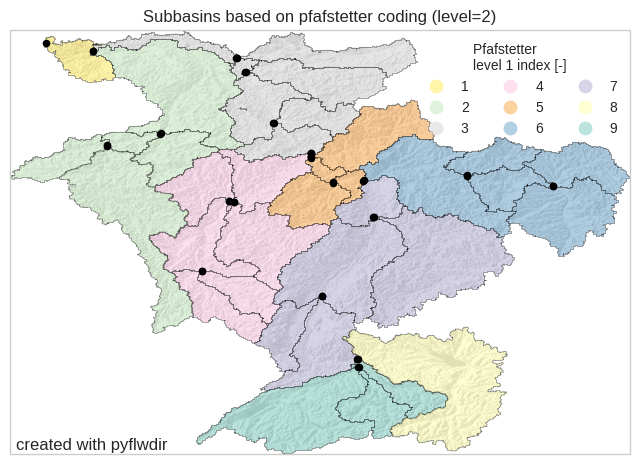
Minimal area based subbasins#
The subbasins_area() method creates subbasins with a minimal area of area_min. Moving upstream from the basin outlets a new subbasin starts at tributaries with a contributing area larger than area_min and new interbasins when its area exceeds the area_min.
[9]:
# calculate subbasins with a minimum stream order 7 and its outlets
min_area = 2000
subbas, idxs_out = flw.subbasins_area(min_area)
# transfrom map and point locations to GeoDataFrames
gdf_subbas = vectorize(subbas.astype(np.int32), 0, flw.transform, name="basin")
# randomize index for visualization
basids = gdf_subbas["basin"].values
gdf_subbas["color"] = np.random.choice(basids, size=basids.size, replace=False)
# plot
gpd_plot_kwds = dict(
column="color", cmap=cm.Set3, edgecolor="black", alpha=0.6, linewidth=0.5
)
bas = (gdf_subbas, gpd_plot_kwds)
title = f"Subbasins based on a minimum area of {min_area} km2"
ax = quickplot([bas], title=title, filename="flw_subbasins_area")
